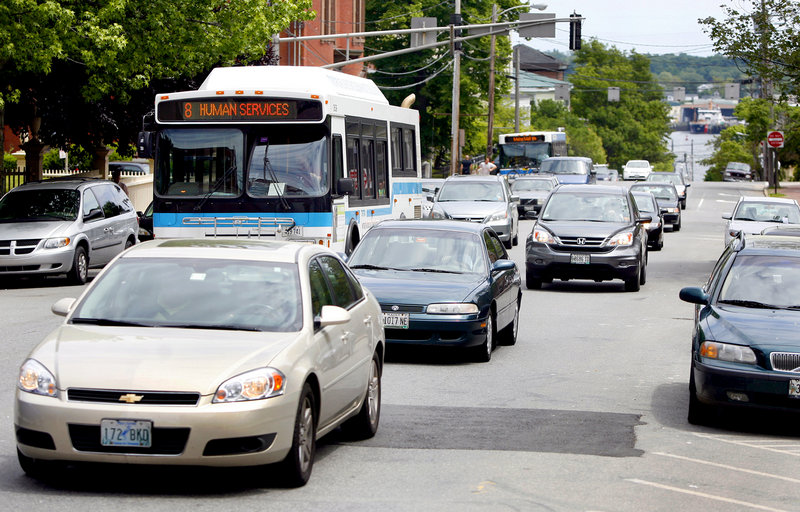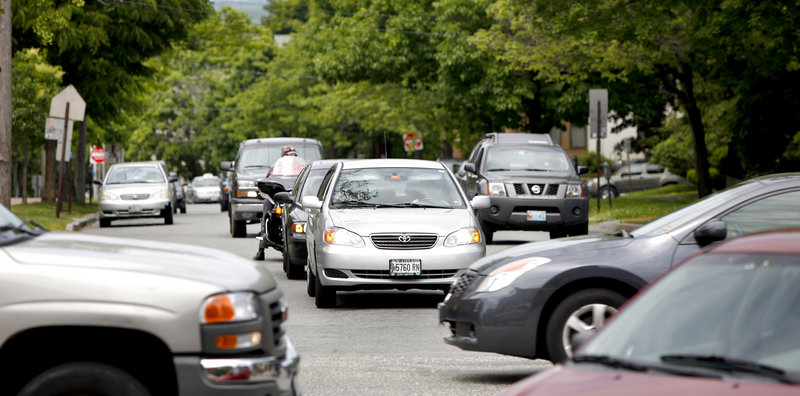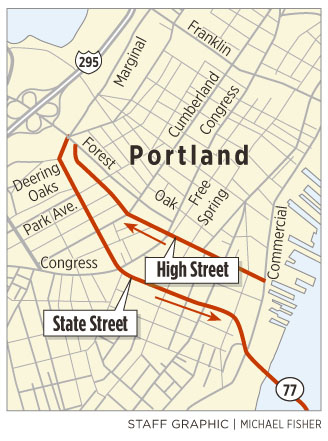PORTLAND — City officials are considering a proposal to convert High and State streets into two-way roads, to make them safer and more accommodating for pedestrians.
The plan’s goal is to slow traffic on two of the city’s busiest arterials, especially traffic going between Interstate 295 and the Casco Bay Bridge.
A similar proposal was floated in 2000, but the discussion focused more on eliminating the State Street extension through Deering Oaks — a change that was opposed by the Maine Department of Transportation.
About five years ago, the city’s Peninsula Transit Study recommended two-way traffic on High and State streets, but the change wasn’t made.
Now, infrastructure improvements such as the Fore River Parkway and the new Veterans Memorial Bridge make the timing right to revisit the proposal, says City Councilor David Marshall, who chairs the council’s Transportation, Sustainability and Energy Committee.
He hopes to get buy-in from the Department of Transportation this time by keeping State Street extension as a two-way road.
“I think it’s worth a new set of eyes,” Marshall said. “We’re trying to look at the whole picture. Times are changing. There’s more emphasis on safety and inviting pedestrians.”
Susan Waltz, who works at Mercy Hospital on State Street, said she crosses the street several times a day. She called the situation “a disaster waiting to happen” and said she is encouraged that the city is looking into the unsafe conditions. Public Services Director Michael Bobinsky said the city’s staff will take the first step June 20 and present Marshall’s committee with details of the study, which would examine project costs, traffic counts on High and State streets, intersection crash rates and computer traffic modeling.
Bobinsky said the city needs updated traffic counts for High and State streets before it decides whether to move ahead with the proposal.
The study, done mostly by city employees, also would examine the potential loss of on-street parking, the changes’ effects on intersections in both Portland and South Portland, and potential infrastructure upgrades at major intersections.
The committee would use the study this summer in considering its recommendation to the council, which would make the decision on the proposal.
State and High streets were two-way until the early 1970s. In the late 1960s, the city hired Victor Gruen Associates to recommend ways to improve Portland’s neighborhoods and downtown. Gruen, known as the father of modern shopping malls, believed in urban renewal and recommended that the city build a variety of interstates and arteries to better connect the downtown with outlying neighborhoods and communities.
Although several of his recommendations were not accepted, several were, including: “Improve access to downtown by completely rebuilding Franklin Street and by converting a renovated High Street and State Street to a one-way pair.”
One local activist has long supported undoing Gruen’s vision.
“These are very negative changes to our life on the peninsula,” said Anne Pringle, president of the Friends of Deering Oaks, noting that most of the buildings along High and State streets are homes. “I view (the proposal) as taking back our city from Victor Gruen’s flawed vision, which is to move cars fast and in great volume.”
Bobinsky said the city would work with businesses, neighborhoods, schools, public transit officials, and state and regional planners, among others, throughout the study and the project, if it’s done.
“It’s certainly a regional transportation link in and out of the city, so we need to be careful about what that means,” he said.
Bobinsky said the study also would look at potential “traffic diversion,” as drivers seek alternative routes, including those through residential neighborhoods.
Marshall said commuter traffic from I-295 to the Casco Bay Bridge could be diverted to West Commercial Street to the Fore River Parkway and the new Veterans Memorial Bridge, which is expected to open this summer.
A state official said the Department of Transportation, whose approval would be needed, would approach the city’s proposal cautiously.
Steve Landry, the assistant state traffic engineer, said the department would have to see computer models showing new traffic flows and proposed upgrades at key intersections before signing off on any new traffic patterns.
“Everything you do will have a reaction someplace else,” Landry said. “We need to know what that reaction is.”
The city is also looking at other major thoroughfares, including Franklin and Spring streets, Marshall said. The City Council recently appointed a task force to recommend changes in conjunction with the renovation of the Cumberland County Civic Center on Spring Street.
On Monday, business owners and residents were intrigued by the idea of making High and State streets two-way.
Andres Verzosa and Yeshe Parks, who were eating lunch at Local Sprouts on Congress Street, were split about the plan.
Verzosa, a Congress Street resident who owns Aucocisco Galleries in the Old Port, supported the idea. He wasn’t sure if the plan would affect his business, but it would improve the feel of the downtown, he said.
“Portland has become a place you like walking around,” Verzosa said.
Although Parks usually bikes into work from outer Washington Avenue to Standard Baking Co. on Commercial Street, he’s not convinced that the two-way streets would solve Portland’s traffic problem. They could actually make it worse, he said.
“I think a left-hand turn could prove to be disastrous,” Parks said. “You could go a whole light (cycle) and not be able to go.”
Staff Writer Randy Billings can be contacted at 791-6346 or at: rbillings@mainetoday.com
Twitter: @randybillings
Send questions/comments to the editors.





